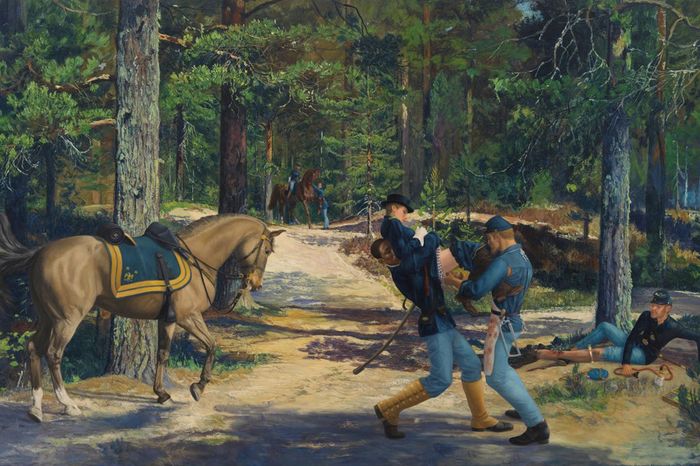
The work of Hilary Harkness makes me think of early Renaissance paintings with their dazzling detail, lyrical line, delicate parts, and highly keyed local color. The sense that you are seeing everything at once. Except the subject matter is a bit different. In 2001, when she was 29, she was attacked for a show that included paintings with hundreds of teeny, almost naked women pegging each other, lithe ladies loading torpedoes on a cutaway submarine, and female sailors lounging in their underwear. She used Old Master technique with sharp BDSM inflections and World War II-era kitsch. People said it was anti-feminist and sexist—and they said the same of me for writing positively about it—but it turns out her themes of sexual dominance and submission were simply ahead of the culture.
Between 2004 and 2011 she had four solo shows that went largely unnoticed. Curators ignored her, and she has still never been in a biennial. No matter. “Painting is my master,” Harkness has said, “that bitch.” Her first exhibition at the excellent PPOW this fall, Prisoners From the Front, made the point that, even at a time of cultural stall, when the galleries are full of super-expensive artists whose work is highly produced and costs a fortune to fabricate, the old masters still hold untapped possibilities.
In 2018, she says she had what can only be called a vision while looking at Winslow Homer’s 1866 painting Prisoners at the Front, which depicts a group of Confederate soldiers who have been captured by a Union general. She imagined an “uncomfortable secret,” changing the race of one of the soldiers and the gender of another, a breakthrough that inspired the rest of the show.
In the front gallery was The Arabella Freeman Series. (Her wife’s name is Ara.) These paintings were loosely arranged according to the years of the Civil War, and they told a tale so layered that it was hard to discern a narrative. Yet what was lost in terms of coherence was gained in intense focus and convincing detail: a world created and maniacally inhabited and explored.
The paintings were generally structured as tableaus set in picturesque landscapes, with figures scattered about. In one, a Black girl in a prom gown, her blouse open to the belly-button, offered a black child to a black female Union soldier. There were Adonis-like soldiers of different races bathing or having sex in the woods. Scenes of sexual rapture between Black and White female lovers; a Black belle sipping tea as an androgynous soldier looks on; two soldiers delivering a Black child from a white Woman. Harkness’s paintings have much of Homer’s non-hierarchical narrative: No one thing is privileged over another.
She also likes to paint, in her words, “dead lesbians.” In the rear gallery were paintings of Gertrude Stein and Alice B. Toklas, who Harkness calls “a stone cold butch.” There was also a posed nude of Josephine Baker talking on a phone. She lay face down, looking at the viewer, as she was massaged by one topless woman, while another woman in a single-strap blue gown exposed one breast. In the background was a rendering of Matisse’s great Joy of Life. “Painting is something either hyper-beautiful, or decorative gory,” Harkness has said. “They are both grotesque in that they are distortions.”

